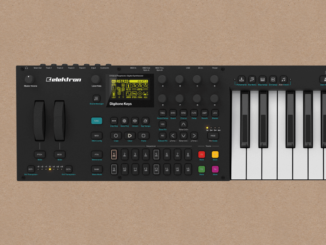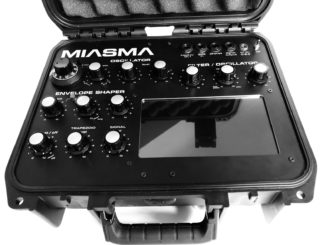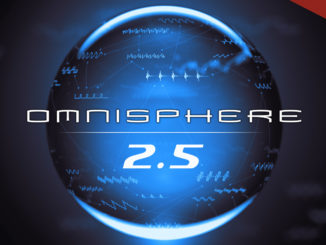Moog Muse is out now: a new analog bi-timbral polyphonic Synthesizer with three oscillators, dual VCF, stereo VCA, and full digital control.
The Muse leak marathon will probably be one of the longest leaks in the music tech world. Partly orchestrated by the marketing department and partly unplanned, it began in February 2024 with Andrew Huang’s post and the Super Bowl.
Further minor leaks followed until the biggest one on July 16th, when everything became known through a shop leak posted on Gearspace. The puzzle game is now finished. It’s time for the official release. The Moog Leak eeh Muse is available now.
Moog Muse
So this is what the Muse looks like. The photos that were leaked previously are correct. It’s very different from the last Moog polyphonic synth, the One.
Muse has a very classic design with lots of knobs (44) but also sliders (16) for the oscillators, mixer, and envelopes—a bit of a different vibe for a Moog synth.
On top, there are colorful buttons and an OLED display. As with the Moog one, small shortcut buttons (cheese wedges) in each section (osc, filter…) take you directly to the features. Wooden side panels complete the design.
For playing, it has a 61 full-size semi-weighted keyboard with velocity and channel aftertouch, no polyAT. Next to this is a pitch and modulation wheel, a macro knob, and two switches: keyboard octaves and hold.
Steve Dunnigton of Moog said they developed for over five years on this new polyphonic flagship Synthesizer, which is being assembled in the US, to the features.
Three Analog Oscillators
Moog Muse is an analog 8-voice bi-timbral polyphonic Synthesizer with an all-analog signal path and advanced digital control. The bi-timbrality allows two independent timbres per patch with stacking or splitting across the keyboard.
At its core are two classic VCOs (sine, sawtooth, reverse sawtooth, square, noise) with wave mix control, PWM, FM, hard sync, and other modulation options. Additionally, there is a modulation oscillator, giving you a third oscillator or a modulation source (LFO).
Two oscillators + mod osc is a classic structure from the legendary Moog Minimoog or the later Voyager, from which the Muse oscillators are derived.
From here, it goes into an analog voltage-controlled mixer section with independent level control over the oscillators (1+2), mod oscillator, and noise. The mixer can also inject ring modulation. The possibility of overloading the mixer (feedback), with which you can create saturation, can not be missed.
Dual Filter, Stereo VCA, And Diffusion Delay
A new feature for a Moog synth is the filter circuit. Yes, it is, again, a classic ladder filter. However, instead of one, the Muse has two transistor ladder filters (1 with highpass/lowpass modes) with linking and different routing options (series, parallel, stereo).
They have classic controls, including cutoff frequency, resonance, keyboard tracking, and envelope amount. Two are better than one filter. Above all, the free routing choice provides flexibility, making many exciting filter manglings possible.
The next step is the VCA section! Muse has a stereo analog voltage-controlled amplifier section with per-timbre control over the volume, pan position, and pan spread.
Part of the new Moog Muse is also a newly developed Diffusion Delay™, a stereo processor inspired by vintage digital rack delays. It adds depth and dimension to any sound. The analog bypass switches allow you to exclude this from the analog signal path at any time.
Digital Control
The Muse interface contains analog and digital technology, allowing for many modern twists. This starts with the freely-assignable modulation engine.
It hosts two multi-wave LFOs (triangle, sawtooth, square, sample-and-hold, user-customizable), a dedicated pitch LFO, and two ADSR envelopes. The latter have variable curves per stage, a multi-trigger option, looping, and velocity control.
This manages a 16-slot, easy-to-use modulation matrix. All this is available per timbre and patch.
Further, Moog added a fully customizable multi-mode arpeggiator per timbre with various controls: clock division, octave range, pattern, direction, gate time, and rhythmic programming. That’s not all. There is also a powerful sequencer.
Moog Muse features a 64-step sequencer with hands-on step editing, adjustable clock divisions, transport controls, and sequence changing. A highlight is the ability to create parameter automations and to work with probability. All your creations can be saved into a sequencer memory with 16 banks of 16 sequences.
Backside
Let’s take a look at the backside. You can find a main stereo output (left/right) without individual outputs for the layers, pedal inputs (sustain, expression), and various mappable CV in/outs.
Next, you have a clock in/out, a full MIDI interface (in/out/thru), a USB port, and a USB host. It’s great to see this, so you can connect the MIDI controller directly with a simple USB cable. And the Muse also has a built-in power supply with a dedicated ON/OFF switch.
Steve Dunnington, Moog engineering veteran of 30 years, expresses the inspiration for this next-generation synth: “With Muse, we’ve created a Moog polysynth that combines the warmth and sonic power of vintage Moog analog technology and the flexibility of digital control to create a deep and expressive instrument for the modern musician to explore and create with.
It’s been a labor of love for everyone involved over the last several years involving many people who worked hard to bring it to life. We are excited and grateful to share the results our team worked hard to achieve — from our in-house product development and design team to the artists we collaborated with to test the instrument’s firmware, develop user presets, and create videos that show Muse’s full functionality.”
First Impression
At this point, I should be able to tell you a lot about the Moog Muse. However, my unit is still waiting to be delivered. In August, I will go into more detail and report on it in moving pictures and writing. Until then, I refer you to my YouTube colleagues.
From the features and the first videos, the new polysynth from Moog sounds lovely and fat—just like a classic Moog should sound in polyphony. It’s priced at 3,4k$/€, so it’s in the Arturia PolyBrute 12 range. That’s a lot of money for a poly synth, but you get a lot for it.
Someone who wants a polyphonic Moog and not a Boog will probably have the “cheapest” opportunity with the Muse. Compared to the Moog One pricing, it’s affordable.
Moog Muse is available now for $3499/3499€ worldwide.
More information here: Moog Music
Available at my partners
Thomann








Very interesting times for buying a Synthesizer.
Can’t say I’m blown away by the sound but I’m not a Moog type of person.
The price however is about right but lots of competition in this price bracket.
12 voice Arturia or 8 voice Moog if you want a keyboard.
I’d not rule out a delia or Nina or an udo.
I’m sure it’s a killer synth – sounds and functions – and will be a huge hit, filling the polyphonic moog hole left by the One, but it’s add odd looking duck, isn’t it? Like someone took a deck of ‘Moog bit’ cards, shuffle them and then just threw them about. Again, sure it’s great, but there’s something off with the design for me.
For me ,it looks like a cross between a behringer and something Yamaha did years ago
Looks great. At first glance, I thought Roland. When I listen to it, I think Diva. Price isn’t too high either, which is nice.
Agreed – they seem to have hit the right spot with the sound/price/features, and it doesn’t seem to have that brittle/fragile oscillator sound of the One either. It’s going to be a massive seller.
As a longtime music & audio pro/synth player, collector and fan, I have mixed feelings about this instrument that I can’t explain? I agree that the Muse borrows cosmetics and aspects of the UI from 70s & 80s Moog, with a dash of Yamaha and Roland, but without the zip somehow? I’d almost prefer to see Jupiter-style black or silver aluminum sides as opposed to the wood…would that change the tone? 😀 I’d ‘really’ have to play this in person and love it, before I would buy it. I’m in the market for exactly what this is right now, there’s a poly analog flagship-sized hole in my studio but there are a ‘lot’ of quality comparables including, at the risk of being sacrilegious, some outstanding software. But – if quality and reliability are up to par, and that feels like a significant ‘if’ based on the headaches of the Moog One as shared by my colleagues – I agree that the price point suggests this could be popular.
I think it looks lovely and very synthy. Wish I had the money and the space 🙂
No poly AT and only 8 voices is very weak. Arturia redefines the market with the new Polybrute keyboard, how advanced! No innovation in Moog land, like digital integration similar to Overbridge that you get with Elektrons. Just the same old technology in a big box, so the only thing they are selling here is the word Moog.
Moog has launched a new class of synthesizers with the Muse: Analog Arranger Synthesizer!